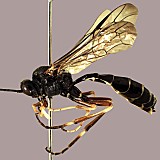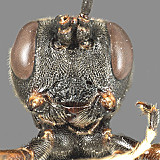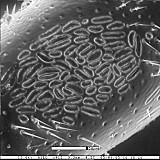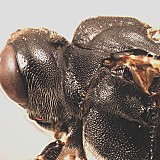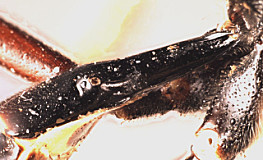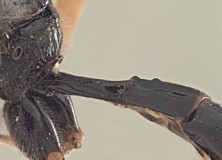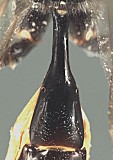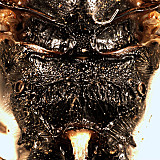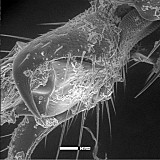Type species: Pergaphaga nigra Gauld, 1984, by original designation; monobasic: only one described species included.
Pergaphaga
In his original description, Gauld (1984) stated that Pergaphaga, along with Dictyopheltes, lacked a glymma, and he used this feature in his key to the Australian genera of ctenopelmatines. A glymma-like depression is present in nearly all individuals that we examined, but is much different in appearence than the glymma of Westwoodia, Gauldia, and Hypopheltes. It is narrow, shallow, and almost slit-like in some specimens, and never as distinct as it is in these other genera.
Pergaphaga is perhaps the least readily characterized of the known westwoodiines, and the species most closely resemble those currently placed in Dictyopheltes. Though the species of Pergaphaga are generally less heavily sculptured than the species of Dictyopheltes, there is considerable variation in degree of sculpturing in both genera, a fact that is not evident unless the more recently described species (Wharton et al. 2010) are taken into consideration. (Gauld, 1984) suggested that Pergaphaga was most closely related to Hypopheltes, from which it is readily distinguished by the nearly absent glymma and the more poorly developed propodeal carinae. Zhaurova and Wharton (2009) suggested the most distinctive feature for defining Pergaphaga might be the presence of a straight to very weakly arched transverse carina extending between the propodeal spiracles that is not found in other westwoodiines, and which is variously developed in the more recently described species.
The species of Pergaphaga and Dictyopheltes are characterized relative to other westwoodiine genera by the shallow to indistinct glymma (Figs 5, 6), with the petiole thus resembling that of certain Euryproctini. The species of Pergaphaga are less heavily sculptured than those of Dictyopheltes, and retain at least some visible carination on the propodeum (Fig. 8). The sternite of the petiole is also slightly longer in Pergaphaga relative to Dictyopheltes.
Head: Clypeal margin varying from blunt to thin, usually more thickened medially, widely truncate, ventral side of margin flattened in at least one species. Clypeus 2.5-2.7 times as broad as long, slightly convex in profile, punctate to transversely rugose, without a median transverse sulcus. Anterior tentorial pits fairly small, elongate, epistomal sulcus distinct throughout. Malar space 0.4-0.6 times basal width of mandible. Mandible with ventral tooth slightly longer than dorsal tooth, or mandibular teeth equal in length, sides parallel over apical 0.7. Face 1.5-1.6 times as broad as long, surface nearly flat to undulating, face dorsally with a median tooth or tubercle, face strongly and densely punctate medially, densely to sparsely punctate laterally, punctation pattern generally matching density of white setae. Interantennal area with or without a prominently raised ridge; when present, ridge extends beyond posterior margin of toruli, splitting into 1 median and 2 lateral carinae, median carina sometimes weakly developed. Frons varying from deeply to almost imperceptibly concave immediately behind scape; varying from flat to strongly elevated adjacent eye; surface matt-punctate to granular between ocelli and eye. Widest diameter of torulus about 1.3-1.5 times widest diameter of median ocellus, ocelli fairly small, not distinctly raised. Distance between lateral ocelli 1.6-2.0 times their widest diameter, distance from lateral ocellus to eye margin 1.6-2.1 times its widest diameter. Vertex finely punctate throughout. Antennae with flagellum as long as to longer than body, with 36-46 flagellomeres. Length of first flagellomere 1.3 times widest transverse diameter of eye, second flagellomere about equal to length of first. Occipital carina complete, joining hypostomal carina distinctly above base of mandible.
Mesosoma: Pronotum dorsally in profile distinctly concave, strongly depressed medially, expanded anteriorly, with truncate anterior margin; transverse sulcus of pronotum dorsally giving rise to distinct lateral groove of pronotum, the latter at least partially interrupted dorsally by a weakly developed epomia; pronotum uniformly densely punctate laterally. Mesoscutum convex in profile and densely punctate; notauli quite prominent, arising at anterior margin of mesoscutum, reaching posterior margin of mesoscutum, or nearly so. Mesopleuron densely punctate ventrally and dorsally, punctures not as dense posteromedially. Mesopleuron with a broad, sharply to fairly sharply defined longitudinal depression for reception of femur. Metapleuron densely punctate. Propodeum rugose, unevenly convex, strongly bulging anteriorly, flatter posteriorly, distance between spiracles 1.4-1.8 times mid-dorsal length, pleural carinae complete, though often very weak in part, median and lateral longitudinal carinae sometimes separated and well-developed medially, or both lateral and median carinae vestigial posteriorly, anterior transverse carina irregular but quite distinct in type species, extending between spiracles; less distinct in other species. Tibia and tarsus slender, longest hind tibial spur longer than greatest apical width of tibia, claws simple.
Wings: Fore wing areolet present or absent, petiolate when present, 3rs-m, when distinct, equal to or only slightly longer than 2rs-m; 1cu-a opposite or very slightly distad Rs+M, almost vertical to slightly inclivous so that anterobasal corner of first subdiscal cell is about 75°; marginal cell narrow; first subdiscal cell not or only slightly explanate distally. Hind wing with first abscissa of Cu1 shorter than or less commonly equal to 1cu-a; distal abscissa of Cu1 pigmented to margin, tubular for most of its length.
Metasoma: T1 long and slender anteriorly, widening distally beyond spiracles, 2.2 or more times as long as posteriorly broad; S1 reaching 0.6 times distance to spiracle. Glymma basal, ventral to dorsal tendon attachment; shallow, narrow to slit-like, almost imperceptible in some individuals. Dorsal tendon attaches to a flat or nearly flat surface; delimited posteriorly by crescentic lines in the type species.
Pergaphaga nigra Gauld has been collected in ACT, New South Wales, and Victoria.
Undescribed species of Pergaphaga are also known from ACT and Victoria.
There are no specimens currently determined for this OTU, or those specimens determined for this OTU are not yet mappable.
This work would not have been possible without the groundwork provided by Ian Gauld’s study of the Australian fauna, and we are particularly grateful for his assistance in many aspects of this study. We also thank the following curators and researchers for extended loans of the material used for this revision: David Wahl (AEIC), John LaSalle (ANIC), Ian Gauld and Gavin Broad (BMNH), Andy Bennett (CNC), Gabriel Melo (DZUP), Anders Albrecht and Pekka Malinen (FMNH), Ronald Zúñiga (INBio), Ken Walker (MVMA), Hege Vårdal (NHRS), Chris Burwell (QM), and Dave Furth (USNM). Matt Yoder provided considerable assistance along the way, particularly with databasing. Images used here were obtained through the combined efforts of Kira Zhaurova, Heather Cummins, and Patricia Mullins. Our use of PURLs (http://purl.oclc.org) follows the example of their use in publications by Norm Johnson. This material was conducted at Texas A&M University and is based upon work supported by the National Science Foundation’s PEET program under Grant No. DEB 0328922 and associated REU supplement nos DEB 0723663 and DEB 0616851. Page last updated September, 2011.
This material is based upon work supported by the National Science Foundation under Grant Number DEB 0328922 with REU supplement DEB 0723663 and DEB 0616851.
Any opinions, findings, and conclusions or recommendations expressed in this material are those of the author(s) and do not necessarily reflect the views of the National Science Foundation.

